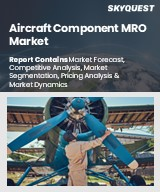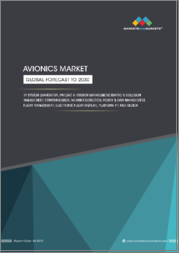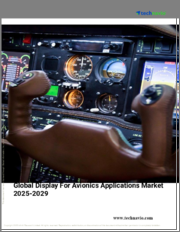
|
시장보고서
상품코드
1468093
군용기용 아비오닉스 시장 보고서 : 시스템 유형별, 항공기 유형별, 최종 용도 분야별, 지역별(2024-2032년)Military Aircraft Avionics Market Report by System Type, Aircraft Type (Combat Aircraft, Helicopters, Unmanned Aerial Vehicles, Transport Aircraft), End Use Sector, and Region 2024-2032 |
||||||
세계의 군용기용 아비오닉스 시장 규모는 2023년에 366억 달러에 달했습니다. 향후 IMARC Group은 2024-2032년에 3.6%의 성장률(CAGR)을 보이며, 2032년까지 507억 달러에 달할 것으로 예측하고 있습니다. 군 및 방위 산업의 번영, 비행 제어 시스템(FCS)에 대한 수요 증가, 첨단 기술 통합 증가는 시장을 촉진하는 주요 요인 중 일부입니다.
군용기용 아비오닉스는 군용 항공기에 사용되는 전자 시스템 및 장비에 초점을 맞춘 작동 가능하고 전투 가능한 변형입니다. 비행 제어, 항법 기능, 전기 광학 및 적외선 위협 센서, 활동 모니터, 안전한 전술 통신, 무기 추적 장비, 대응 조치 디스펜서 및 기타 통합된 전자 지원, 보호 및 공격 기능으로 구성됩니다. 특수한 재료로 제조되거나 상용 장비보다 적에게 더 강한 용기에 담겨있어 열악한 환경의 손상을 견딜 수 있습니다. 군용 항공기는 임무 수행, 성능 측정값 추적 및 보고, 발견, 안전 매개변수 내에서의 운용, 항공기의 전반적인 성능 향상을 돕습니다. 군용 항공기 통신에 기존에 사용되던 고주파(HF), 초고주파(VHF), 초고주파(UHF) 시스템에서 무선통신을 대체할 수 있도록 지원합니다. 엔진 제어, 전자전, 감시, 지리공간 정보, 전력 및 에너지 관리 등에 사용됩니다.
군용기용 아비오닉스 시장 동향 :
현재 장거리 표적 탐지 및 추적, 스텔스, 전자전 방어 등 차세대 전장 요건을 충족하기 위해 군용기용 아비오닉스에 대한 수요가 증가하고 있습니다. 이는 번성하는 군 및 방위 산업과 함께 시장 성장을 지원하는 중요한 요인 중 하나입니다. 또한 여러 국가들이 자국 함대를 현대화하고 확장하기 위해 차세대 군용기를 개발 및 조달하고 있으며, 이는 시장 성장을 가속하고 있습니다. 이 외에도 자동조종장비, 데이터 수집 시스템, 비행기록장비, 항공기 관리 컴퓨터 개조, 액티브 인셉터 시스템, 정전기 작동(EHA) 시스템 등 군용 항공기의 비행 제어 시스템(FCS)에 대한 수요가 증가하고 있습니다. 이는 전자전, 해상 순찰, 공중 조기경보통제시스템(AEW/C), 대지전(ASW)에 대한 수요 증가와 맞물려 시장 성장을 가속하고 있습니다. 또한 항공기 주문자 상표 부착 제품 제조업체(OEM)는 차세대 항공기에 탑재될 첨단 비행 제어 시스템을 개발 및 통합하기 위해 항공전자 제조업체와 협력하고 있습니다. 또한 인공지능(AI), 빅데이터 등 첨단 기술을 컴퓨터에 통합하여 유-무인 항공기의 자율 비행을 강화하는 데 주력하고 있습니다. 이와는 별도로 전자전 스위트, 능동형 인셉터 시스템, 차량 관리 컴퓨터에 대한 수요 증가는 시장에 긍정적인 영향을 미치고 있습니다.
이 보고서에서 다룬 주요 질문
- 세계 군용기용 아비오닉스 시장 규모는?
- 2024-2032년 세계의 군용기용 아비오닉스 시장 성장률 전망은?
- 세계 군용기 아비오닉스 시장을 촉진하는 주요 요인은?
- COVID-19가 세계 군용기 아비오닉스 시장에 미치는 영향은?
- 세계 군용기용 아비오닉스 시장의 항공기 유형별 분류는?
- 세계의 군용기용 아비오닉스 시장 최종 용도별 분류는?
- 세계의 군용기용 아비오닉스 시장내 주요 지역은?
- 세계 군용기용 아비오닉스 시장에 진출한 주요 업체는?
목차
제1장 서문
제2장 조사 범위와 조사 방법
- 조사 목적
- 이해관계자
- 데이터 소스
- 1차 정보
- 2차 정보
- 시장 추정
- 보텀업 어프로치
- 톱다운 어프로치
- 조사 방법
제3장 주요 요약
제4장 서론
- 개요
- 주요 산업 동향
제5장 세계의 군용기용 아비오닉스 시장
- 시장 개요
- 시장 실적
- COVID-19의 영향
- 시장 예측
제6장 시장 내역 : 시스템 유형별
- 비행 제어 시스템
- 통신 시스템
- 내비게이션 시스템
- 모니터링 시스템
- 기타
제7장 시장 내역 : 항공기 유형별
- 전투기
- 헬리콥터
- 무인항공기(UAV)
- 운송기
제8장 시장 내역 : 최종 용도 분야별
- OEM
- 애프터마켓
제9장 시장 내역 : 지역별
- 북미
- 미국
- 캐나다
- 아시아태평양
- 중국
- 일본
- 인도
- 한국
- 호주
- 인도네시아
- 기타
- 유럽
- 독일
- 프랑스
- 영국
- 이탈리아
- 스페인
- 러시아
- 기타
- 라틴아메리카
- 브라질
- 멕시코
- 기타
- 중동 및 아프리카
- 시장 동향
- 시장 내역 : 국가별
- 시장 예측
제10장 SWOT 분석
- 개요
- 강점
- 약점
- 기회
- 위협
제11장 밸류체인 분석
제12장 Porter's Five Forces 분석
- 개요
- 구매자의 교섭력
- 공급 기업의 교섭력
- 경쟁의 정도
- 신규 진출업체의 위협
- 대체품의 위협
제13장 가격 분석
제14장 경쟁 구도
- 시장 구조
- 주요 기업
- 주요 기업의 개요
- BAE Systems Plc
- Cobham
- Curtiss-Wright Corporation
- Elbit Systems Ltd.
- GE Aviation Co.
- Honeywell International Inc.
- L3Harris Technologies Inc.
- Lockheed Martin Corporation
- Moog Inc.
- Raytheon Technologies Corporation
- Thales Group
The global military aircraft avionics market size reached US$ 36.6 Billion in 2023. Looking forward, IMARC Group expects the market to reach US$ 50.7 Billion by 2032, exhibiting a growth rate (CAGR) of 3.6% during 2024-2032. The thriving military and defense industry, increasing demand for flight control systems (FCS), and rising integration of advanced technologies represent some of the key factors driving the market.
Military aircraft avionics are operational and combat-ready variations that focus on electronic systems and equipment used in military aircraft. They comprise flight control, navigation functions, electro-optic and infrared threat sensors, activity monitors, secure tactical communications, weapons trackers, countermeasures dispensers, and other integrated electronic support, protection, and attack capabilities. They can resist damage from the harsh environment as they are manufactured from special materials or encased in more adversary-resistant containers compared to commercially available equipment. Military aircraft help accomplish missions, track and report performance measures, make discoveries, operate within safety parameters, and improve overall aircraft performance. They assist in replacing radio communication with high frequency (HF), very high frequency (VHF), and ultra-high frequency (UHF) systems that are conventionally used for military aircraft communication. They are used in engine control, electronic warfare, surveillance, geospatial intelligence, and power and energy management.
Military Aircraft Avionics Market Trends:
At present, there is a rise in the demand for military aircraft avionics to meet the newer generation battlefield requirements, such as long-distance target detection and tracking, stealth, and electronic warfare defense. This, along with the thriving military and defense industry, represents one of the key factors supporting the growth of the market. In addition, several countries are developing and procuring next-generation military aircraft to modernize and expand their fleets, which is propelling the growth of the market. Besides this, there is an increase in the demand for flight control systems (FCS) in military aircraft, such as autopilot, data acquisition systems, flight recorders, refurbishing aircraft management computers, active inceptor systems, and electrohydrostatic actuation (EHA) systems. This, coupled with the rising demand for electronic warfare, maritime patrol, airborne early warning control systems (AEW/C), and anti-surface warfare (ASW), is strengthening the growth of the market. In addition, the aircraft original equipment manufacturers (OEMs) are partnering with the avionics manufacturers to develop and integrate advanced flight control systems onboard the new-generation aircraft. They are also focusing on integrating advanced technologies, such as artificial intelligence (AI) and big data, into computers to enhance the autonomous operations of human-crewed and uncrewed aircraft. Apart from this, the growing demand for electronic warfare suites, active inceptor systems, and vehicle management computers is positively influencing the market.
Key Market Segmentation:
IMARC Group provides an analysis of the key trends in each sub-segment of the global military aircraft avionics market report, along with forecasts at the global, regional and country level from 2024-2032. Our report has categorized the market based on system type, aircraft type and end use sector.
System Type Insights:
Flight Control System
Communication System
Navigation System
Monitoring System
Others
The report has provided a detailed breakup and analysis of the military aircraft avionics market based on the system type. This includes flight control system, communication system, navigation system, monitoring system, and others.
Aircraft Type Insights:
Combat Aircraft
Helicopters
Unmanned Aerial Vehicles (UAVs)
Transport Aircraft
A detailed breakup and analysis of the military aircraft avionics market based on the aircraft type has also been provided in the report. This includes combat aircraft, helicopters, unmanned aerial vehicles (UAVs), and transport aircraft. According to the report, combat aircraft accounted for the largest market share.
End Use Sector Insights:
OEM
Aftermarket
A detailed breakup and analysis of the military aircraft avionics market based on the end use sector has also been provided in the report. This includes OEM and aftermarket. According to the report, aftermarket accounted for the largest market share.
Regional Insights:
North America
United States
Canada
Asia-Pacific
China
Japan
India
South Korea
Australia
Indonesia
Others
Europe
Germany
France
United Kingdom
Italy
Spain
Russia
Others
Latin America
Brazil
Mexico
Others
Middle East and Africa
The report has also provided a comprehensive analysis of all the major regional markets, which include North America (the United States and Canada); Asia Pacific (China, Japan, India, South Korea, Australia, Indonesia, and others); Europe (Germany, France, the United Kingdom, Italy, Spain, Russia, and others); Latin America (Brazil, Mexico, and others); and the Middle East and Africa. According to the report, North America (the United States and Canada) was the largest market for military aircraft avionics. Some of the factors driving the North America military aircraft avionics market included the growing investments in military and defense industry, rising demand for advanced military aircraft, increasing need for modernizing communication avionics, etc.
Competitive Landscape:
The report has also provided a comprehensive analysis of the competitive landscape in the global military aircraft avionics market. Competitive analysis such as market structure, market share by key players, player positioning, top winning strategies, competitive dashboard, and company evaluation quadrant has been covered in the report. Also, detailed profiles of all major companies have been provided. Some of the companies covered include BAE Systems Plc, Cobham, Curtiss-Wright Corporation, Elbit Systems Ltd., GE Aviation Co., Honeywell International Inc., L3Harris Technologies Inc., Lockheed Martin Corporation, Moog Inc., Raytheon Technologies Corporation, Thales Group, etc. Kindly note that this only represents a partial list of companies, and the complete list has been provided in the report.
Key Questions Answered in This Report
- 1. How big is the global military aircraft avionics market?
- 2. What is the expected growth rate of the global military aircraft avionics market during 2024-2032?
- 3. What are the key factors driving the global military aircraft avionics market?
- 4. What has been the impact of COVID-19 on the global military aircraft avionics market?
- 5. What is the breakup of the global military aircraft avionics market based on the aircraft type?
- 6. What is the breakup of the global military aircraft avionics market based on the end use sector?
- 7. What are the key regions in the global military aircraft avionics market?
- 8. Who are the key players/companies in the global military aircraft avionics market?
Table of Contents
1 Preface
2 Scope and Methodology
- 2.1 Objectives of the Study
- 2.2 Stakeholders
- 2.3 Data Sources
- 2.3.1 Primary Sources
- 2.3.2 Secondary Sources
- 2.4 Market Estimation
- 2.4.1 Bottom-Up Approach
- 2.4.2 Top-Down Approach
- 2.5 Forecasting Methodology
3 Executive Summary
4 Introduction
- 4.1 Overview
- 4.2 Key Industry Trends
5 Global Military Aircraft Avionics Market
- 5.1 Market Overview
- 5.2 Market Performance
- 5.3 Impact of COVID-19
- 5.4 Market Forecast
6 Market Breakup by System Type
- 6.1 Flight Control System
- 6.1.1 Market Trends
- 6.1.2 Market Forecast
- 6.2 Communication System
- 6.2.1 Market Trends
- 6.2.2 Market Forecast
- 6.3 Navigation System
- 6.3.1 Market Trends
- 6.3.2 Market Forecast
- 6.4 Monitoring System
- 6.4.1 Market Trends
- 6.4.2 Market Forecast
- 6.5 Others
- 6.5.1 Market Trends
- 6.5.2 Market Forecast
7 Market Breakup by Aircraft Type
- 7.1 Combat Aircraft
- 7.1.1 Market Trends
- 7.1.2 Market Forecast
- 7.2 Helicopters
- 7.2.1 Market Trends
- 7.2.2 Market Forecast
- 7.3 Unmanned Aerial Vehicles (UAVs)
- 7.3.1 Market Trends
- 7.3.2 Market Forecast
- 7.4 Transport Aircraft
- 7.4.1 Market Trends
- 7.4.2 Market Forecast
8 Market Breakup by End Use Sector
- 8.1 OEM
- 8.1.1 Market Trends
- 8.1.2 Market Forecast
- 8.2 Aftermarket
- 8.2.1 Market Trends
- 8.2.2 Market Forecast
9 Market Breakup by Region
- 9.1 North America
- 9.1.1 United States
- 9.1.1.1 Market Trends
- 9.1.1.2 Market Forecast
- 9.1.2 Canada
- 9.1.2.1 Market Trends
- 9.1.2.2 Market Forecast
- 9.1.1 United States
- 9.2 Asia-Pacific
- 9.2.1 China
- 9.2.1.1 Market Trends
- 9.2.1.2 Market Forecast
- 9.2.2 Japan
- 9.2.2.1 Market Trends
- 9.2.2.2 Market Forecast
- 9.2.3 India
- 9.2.3.1 Market Trends
- 9.2.3.2 Market Forecast
- 9.2.4 South Korea
- 9.2.4.1 Market Trends
- 9.2.4.2 Market Forecast
- 9.2.5 Australia
- 9.2.5.1 Market Trends
- 9.2.5.2 Market Forecast
- 9.2.6 Indonesia
- 9.2.6.1 Market Trends
- 9.2.6.2 Market Forecast
- 9.2.7 Others
- 9.2.7.1 Market Trends
- 9.2.7.2 Market Forecast
- 9.2.1 China
- 9.3 Europe
- 9.3.1 Germany
- 9.3.1.1 Market Trends
- 9.3.1.2 Market Forecast
- 9.3.2 France
- 9.3.2.1 Market Trends
- 9.3.2.2 Market Forecast
- 9.3.3 United Kingdom
- 9.3.3.1 Market Trends
- 9.3.3.2 Market Forecast
- 9.3.4 Italy
- 9.3.4.1 Market Trends
- 9.3.4.2 Market Forecast
- 9.3.5 Spain
- 9.3.5.1 Market Trends
- 9.3.5.2 Market Forecast
- 9.3.6 Russia
- 9.3.6.1 Market Trends
- 9.3.6.2 Market Forecast
- 9.3.7 Others
- 9.3.7.1 Market Trends
- 9.3.7.2 Market Forecast
- 9.3.1 Germany
- 9.4 Latin America
- 9.4.1 Brazil
- 9.4.1.1 Market Trends
- 9.4.1.2 Market Forecast
- 9.4.2 Mexico
- 9.4.2.1 Market Trends
- 9.4.2.2 Market Forecast
- 9.4.3 Others
- 9.4.3.1 Market Trends
- 9.4.3.2 Market Forecast
- 9.4.1 Brazil
- 9.5 Middle East and Africa
- 9.5.1 Market Trends
- 9.5.2 Market Breakup by Country
- 9.5.3 Market Forecast
10 SWOT Analysis
- 10.1 Overview
- 10.2 Strengths
- 10.3 Weaknesses
- 10.4 Opportunities
- 10.5 Threats
11 Value Chain Analysis
12 Porters Five Forces Analysis
- 12.1 Overview
- 12.2 Bargaining Power of Buyers
- 12.3 Bargaining Power of Suppliers
- 12.4 Degree of Competition
- 12.5 Threat of New Entrants
- 12.6 Threat of Substitutes
13 Price Analysis
14 Competitive Landscape
- 14.1 Market Structure
- 14.2 Key Players
- 14.3 Profiles of Key Players
- 14.3.1 BAE Systems Plc
- 14.3.1.1 Company Overview
- 14.3.1.2 Product Portfolio
- 14.3.1.3 Financials
- 14.3.1.4 SWOT Analysis
- 14.3.2 Cobham
- 14.3.2.1 Company Overview
- 14.3.2.2 Product Portfolio
- 14.3.2.3 Financials
- 14.3.2.4 SWOT Analysis
- 14.3.3 Curtiss-Wright Corporation
- 14.3.3.1 Company Overview
- 14.3.3.2 Product Portfolio
- 14.3.3.3 Financials
- 14.3.3.4 SWOT Analysis
- 14.3.4 Elbit Systems Ltd.
- 14.3.4.1 Company Overview
- 14.3.4.2 Product Portfolio
- 14.3.4.3 Financials
- 14.3.5 GE Aviation Co.
- 14.3.5.1 Company Overview
- 14.3.5.2 Product Portfolio
- 14.3.6 Honeywell International Inc.
- 14.3.6.1 Company Overview
- 14.3.6.2 Product Portfolio
- 14.3.6.3 Financials
- 14.3.6.4 SWOT Analysis
- 14.3.7 L3Harris Technologies Inc.
- 14.3.7.1 Company Overview
- 14.3.7.2 Product Portfolio
- 14.3.7.3 SWOT Analysis
- 14.3.8 Lockheed Martin Corporation
- 14.3.8.1 Company Overview
- 14.3.8.2 Product Portfolio
- 14.3.8.3 Financials
- 14.3.8.4 SWOT Analysis
- 14.3.9 Moog Inc.
- 14.3.9.1 Company Overview
- 14.3.9.2 Product Portfolio
- 14.3.9.3 Financials
- 14.3.9.4 SWOT Analysis
- 14.3.10 Raytheon Technologies Corporation
- 14.3.10.1 Company Overview
- 14.3.10.2 Product Portfolio
- 14.3.10.3 Financials
- 14.3.10.4 SWOT Analysis
- 14.3.11 Thales Group
- 14.3.11.1 Company Overview
- 14.3.11.2 Product Portfolio
- 14.3.11.3 Financials
- 14.3.11.4 SWOT Analysis
- 14.3.1 BAE Systems Plc

















